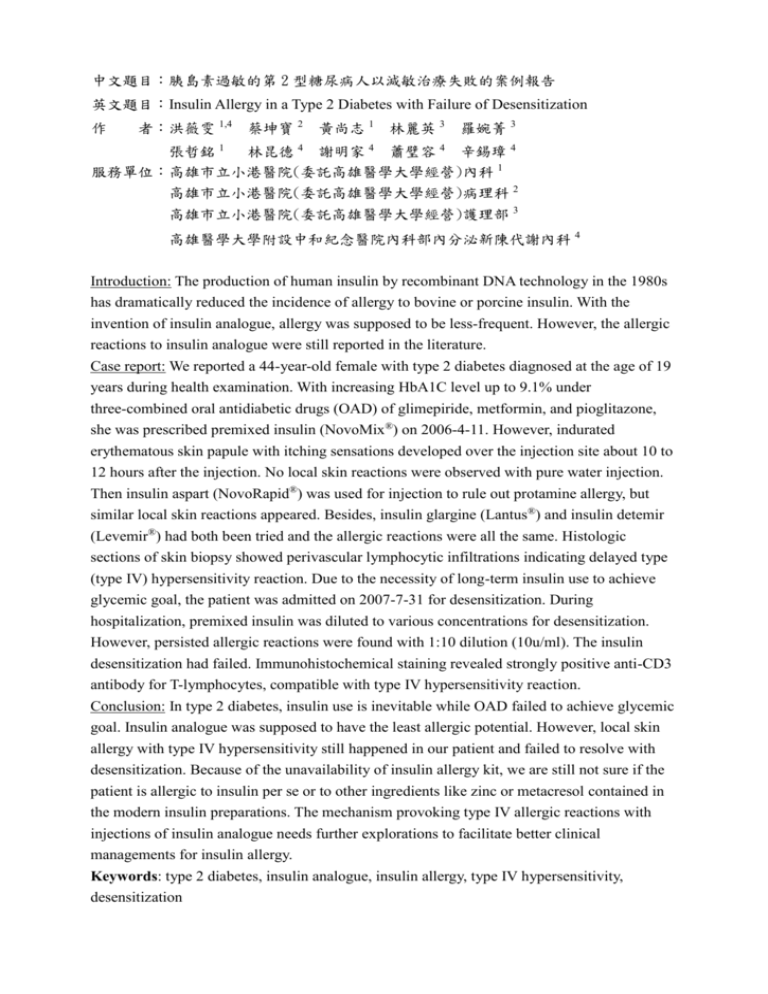胰島素過敏的第2型糖尿病人以減敏治療失敗的案例報告
advertisement

中文題目:胰島素過敏的第 2 型糖尿病人以減敏治療失敗的案例報告 英文題目:Insulin Allergy in a Type 2 Diabetes with Failure of Desensitization 作 者:洪薇雯 1,4 蔡坤寶 2 黃尚志 1 林麗英 3 羅婉菁 3 張哲銘 1 林昆德 4 謝明家 4 蕭璧容 4 辛錫璋 4 服務單位:高雄市立小港醫院(委託高雄醫學大學經營)內科 1 高雄市立小港醫院(委託高雄醫學大學經營)病理科 2 高雄市立小港醫院(委託高雄醫學大學經營)護理部 3 高雄醫學大學附設中和紀念醫院內科部內分泌新陳代謝內科 4 Introduction: The production of human insulin by recombinant DNA technology in the 1980s has dramatically reduced the incidence of allergy to bovine or porcine insulin. With the invention of insulin analogue, allergy was supposed to be less-frequent. However, the allergic reactions to insulin analogue were still reported in the literature. Case report: We reported a 44-year-old female with type 2 diabetes diagnosed at the age of 19 years during health examination. With increasing HbA1C level up to 9.1% under three-combined oral antidiabetic drugs (OAD) of glimepiride, metformin, and pioglitazone, she was prescribed premixed insulin (NovoMix®) on 2006-4-11. However, indurated erythematous skin papule with itching sensations developed over the injection site about 10 to 12 hours after the injection. No local skin reactions were observed with pure water injection. Then insulin aspart (NovoRapid®) was used for injection to rule out protamine allergy, but similar local skin reactions appeared. Besides, insulin glargine (Lantus®) and insulin detemir (Levemir®) had both been tried and the allergic reactions were all the same. Histologic sections of skin biopsy showed perivascular lymphocytic infiltrations indicating delayed type (type IV) hypersensitivity reaction. Due to the necessity of long-term insulin use to achieve glycemic goal, the patient was admitted on 2007-7-31 for desensitization. During hospitalization, premixed insulin was diluted to various concentrations for desensitization. However, persisted allergic reactions were found with 1:10 dilution (10u/ml). The insulin desensitization had failed. Immunohistochemical staining revealed strongly positive anti-CD3 antibody for T-lymphocytes, compatible with type IV hypersensitivity reaction. Conclusion: In type 2 diabetes, insulin use is inevitable while OAD failed to achieve glycemic goal. Insulin analogue was supposed to have the least allergic potential. However, local skin allergy with type IV hypersensitivity still happened in our patient and failed to resolve with desensitization. Because of the unavailability of insulin allergy kit, we are still not sure if the patient is allergic to insulin per se or to other ingredients like zinc or metacresol contained in the modern insulin preparations. The mechanism provoking type IV allergic reactions with injections of insulin analogue needs further explorations to facilitate better clinical managements for insulin allergy. Keywords: type 2 diabetes, insulin analogue, insulin allergy, type IV hypersensitivity, desensitization






